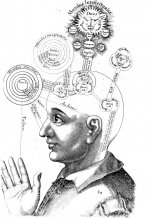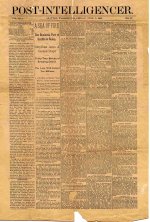This is one of the most famous buildings in Seattle, and rightfully so. The structure is pretty stunning. The history of its construction has a bit of a mystery to it. Of course, this mystery is not exactly on the surface for everyone to see. One would have to actually investigate, to see the abnormalities. Let's start with the narrative.
I could not find a better contemporary image of the Pioneer Building. There will be older photographs down the article, and those, in my opinion, represent this structure much better.

The Pioneer Building is a 94-foot-tall (29 m) symmetrical block, measuring 115 by 111 ft (35 by 34 m). The exterior walls are constructed of Bellingham Bay gray sandstone at the basement and first floor, with red brick on the upper five floors (with the exception of two stone pilasters which extended to the full height of the tower over the main entrance). Spandrel panels and other ornamental elements are terra cotta from Gladding, McBean in California. There are three projecting bays of cast iron, the curved bays at the corner and on the James Street facade, and the angled bay above the main entrance.
Well, this is basically it, as far as available information goes. Everything we have is virtually useless, for it contains no real history. Here are some of the "history" covering links we have:

Please take a look at some of the projects attributed to this gentleman. Check out a different source emphasizing the issue we have with this guy.

Here is the last thing(s) we know about Elmer Fisher:
If we were to believe the Seattle Public Library we have the following narrative compliant data for the Yesler-Leary Building:
I was struggling to find a better post-fire view North from the Pioneer Square on the 1st Avenue. That's because it used to have a different name in 1889. Apparently it was called Front Street. Anyways, here is the direction we need.

Below we have a photograph covering the direction indicated by the above arrows. I believe the photograph was taken slightly south of 1st Ave and Marion street intersection.

Essentially, the entire area got annihilated. The below map of the 1889 Great Seattle Fire could have a better resolution, but you get an idea.

As the story goes, Seattle quickly rebuilt using brick buildings that sat 20 feet above the original street level. Help yourself.
#1: 1st Ave., looking north from Pioneer Square, ca. 1890.

Several Zoom-ins





In reference to the above c. 1890 photographs:

#1: Under what circumstances could we have the below:


#2: How was this 1890 magazine possible?


KD: I think there is something seriously wrong with this entire story line. Prior to 1889, cities in this area chose not to burn. Then year 1889 decided to visit the Washington Territory:
The Pioneer Building
The Pioneer Building is a Richardsonian Romanesque stone, red brick, terra cotta, and cast iron building located on the northeast corner of First Avenue and James Street, in Seattle's Pioneer Square District. Completed in 1892, the Pioneer Building was designed by architect Elmer Fisher, who designed several of the historic district's new buildings following the Great Seattle Fire of 1889.I could not find a better contemporary image of the Pioneer Building. There will be older photographs down the article, and those, in my opinion, represent this structure much better.
The Pioneer Building is a 94-foot-tall (29 m) symmetrical block, measuring 115 by 111 ft (35 by 34 m). The exterior walls are constructed of Bellingham Bay gray sandstone at the basement and first floor, with red brick on the upper five floors (with the exception of two stone pilasters which extended to the full height of the tower over the main entrance). Spandrel panels and other ornamental elements are terra cotta from Gladding, McBean in California. There are three projecting bays of cast iron, the curved bays at the corner and on the James Street facade, and the angled bay above the main entrance.
- The building reflects a mix of Victorian and Romanesque Revival influences. The facades, with vertical pilasters and horizontal belt courses creating a grid, reflect Victorian compositional strategies. Details such as the round arches over groups of windows and the arched main entrance and corner entrance are Romanesque Revival elements.
- The exterior walls are load-bearing, as is the firewall that extends through the building from the street to the alley. The interior structure is cast iron columns and steel beams supporting timber joists. As was typical practice in the period, the office floors were designed and built with permanent partitions forming 185 office rooms -a tenant would simply rent one or more office rooms. Light is provided to the interior through two atria—one in the center of the south portion of the building, the other in the north portion of the building.
- Constructed at a cost of $270,000, the Pioneer Building was considered one of Seattle's finest post-fire business blocks. It has always been highly visible, forming a portion of one side of Seattle's Pioneer Place Park.
- The Pioneer Building originally had a seventh floor tower room (with a pyramidal roof) located directly above the front entrance making the building 110 ft (34 m). It was removed as a result of damage caused by the 1949 earthquake.
c. 1890

Well, this is basically it, as far as available information goes. Everything we have is virtually useless, for it contains no real history. Here are some of the "history" covering links we have:
- Pioneer Building - Wikipedia
- PCAD - Pioneer Building
- Pioneer Building - Seattle, Washington
- Pioneer Building - Seattle
- The Pioneer Building
- Pioneer Building
The Architect
As was stated above, the building was designed by Elmer Fisher. He was born either c. 1840 in Scotland, or c. 1851 in the US. The gentleman supposedly died in 1905. As far as I understand, there is only one photograph of Mr. Fisher, and you can see it below. SH Blog already has an article dedicated to this specific architect:
Here is the last thing(s) we know about Elmer Fisher:
- His official date of death as well as his final resting place is unknown.
- He died in 1905, an architectural draftsman and carpenter.
Yesler-Leary Building
This building should have an article of its own. Yet, for the purposes of this article, we absolutely have to mention it, because up until 1889 it was the most prominent building in Seattle. This building will allow us to cover the area where the Pioneer Building will later stand.c. 1887

Here is one additional view of this Yesler-Leary Building:
If we were to believe the Seattle Public Library we have the following narrative compliant data for the Yesler-Leary Building:
- Built: 1883
- Destroyed: 1889
- The Yesler-Leary Building burned down in the Great Seattle Fire of 1889
- Yesler-Leary Building and 1st Ave
- PCAD - Yesler-Leary Building, Pioneer Square
- Yesler-Leary Building
The Great Seattle Fire of 1889
The Great Seattle Fire was a fire that destroyed the entire central business district of Seattle, Washington on June 6, 1889. The conflagration lasted for less than a day, burning through the afternoon and into the night, and during the same summer as the Great Spokane Fire and the Great Ellensburg Fire. Seattle quickly rebuilt using brick buildings that sat 20 feet (6.1 m) above the original street level. Its population swelled during reconstruction, becoming the largest city in the newly admitted state of Washington.Yesler-Leary Building in 1889

I was struggling to find a better post-fire view North from the Pioneer Square on the 1st Avenue. That's because it used to have a different name in 1889. Apparently it was called Front Street. Anyways, here is the direction we need.
- Today's 1st Avenue was Front Street north of Yesler in Arthur A. Denny's plat, and Commercial Street to its south in Doc Maynard's.
Below we have a photograph covering the direction indicated by the above arrows. I believe the photograph was taken slightly south of 1st Ave and Marion street intersection.
Essentially, the entire area got annihilated. The below map of the 1889 Great Seattle Fire could have a better resolution, but you get an idea.
- #3: Yesler-Leary Building
- #4: Occidental Hotel
- Full Map
As the story goes, Seattle quickly rebuilt using brick buildings that sat 20 feet above the original street level. Help yourself.
Construction of the Pioneer Building
From the official narrative we know that the Great Seattle Fire happened on 06/06/1889. From the same narrative we get statements similar to the below ones:- By the time the fire swept through the city, the foundation for the new Pioneer Building had already been excavated.
- The ensuing construction boom slowed the completion of the Pioneer Building.
- When it was completed in 1892, the beautiful building of red brick and terra cotta was arguably the finest "fireproof" Richardsonian-Romanesque designs created by architect Elmer H. Fisher.
- Source
Construction Photographs
I was real surprised to find photographs resembling the construction. Well, may be they do demonstrate construction processes utilized in 1890's, I do not know for sure.- Photographs are zoomable at their source.
- In the below photographs, we are looking North on 1st Ave aka Front street, and the photographer was more or less on top of the Pioneer Square. Naturally, we are seeing 1st Avenue North from the Pioneer Square.
- The Pioneer Building is being built in the right.
#1: 1st Ave., looking north from Pioneer Square, ca. 1890.
- Shows Merchants National Bank and the Starr-Boyd Building to the left, Pioneer Building under construction on the right.
c. 1890

#2: 1st Ave., looking north from Pioneer Square, ca. 1890
- Handwritten on verso: Pioneer Square under construction.
Several Zoom-ins
In reference to the above c. 1890 photographs:
- There appears to be no issues photographing in motion in 1890.
- This entire area was annihilated on 06/06/1889.
- Surrounding structures do not look brand new to me.
- The Pioneer Building being built on the right. Is this what a superfast construction process should look like?
Abnormalities
I know that I have repeated this many times already. Per the narrative, this entire area was destroyed by an alleged urban fire on 06/06/1889.Zoomable
#1: Under what circumstances could we have the below:
- Red-squared is our Pioneer Building
- 08/23/1890 - West Shore. An Illustrated Journal.
- The Pioneer Building is obviously there (as well as many other buildings).
KD: I think there is something seriously wrong with this entire story line. Prior to 1889, cities in this area chose not to burn. Then year 1889 decided to visit the Washington Territory:
- 06/06/1889 - Great Seattle Fire
- 07/04/1889 - Great Ellensburg Fire
- 08/04/1889 - Great Spokane Fire
- Additionally, in 1889 we had fires in Republic, Cheney, Vancouver and god knows where else in WA.
- Sounds like it was a war, or something very similar to it.
- When do you think it was built?
- Was the above presented construction real, or staged?
- Link #1
- Link #2
- 1891 Promotional booklet produced to encourage individuals to move to Seattle.



